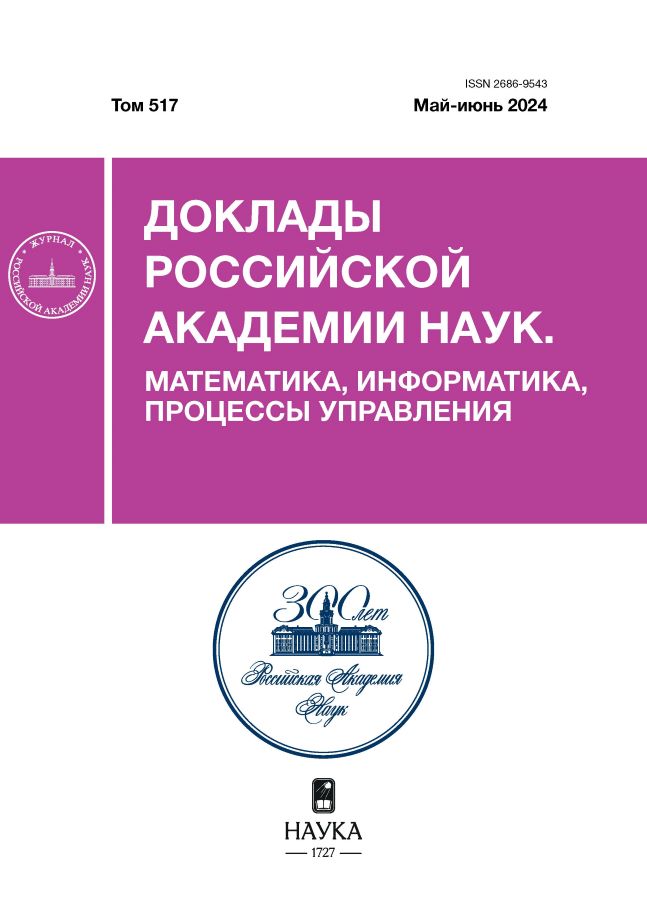On quantitative assessment of chirality: right-sided and left-sided geometric objects
- Authors: Kriksin Y.A.1, Tishkin V.F.1
-
Affiliations:
- Keldysh Institute of Applied Mathematics of Russian Academy of Sciences
- Issue: Vol 517 (2024)
- Pages: 22-29
- Section: MATHEMATICS
- URL: https://medjrf.com/2686-9543/article/view/647970
- DOI: https://doi.org/10.31857/S2686954324030038
- EDN: https://elibrary.ru/YBRYDC
- ID: 647970
Cite item
Abstract
Two methods for quantitatively assessing the chirality of a set are considered, the first of which uses the calculation of the area of their symmetric difference of two sets as a measure of the discrepancy between them, and the second uses the Hausdorff distance between them. It is shown that these methods, generally speaking, do not provide a correct quantitative estimate for a fairly wide class of sets, such as bounded Borel sets. Using the example of flat triangles and convex quadrangles, the problem of dividing geometric objects into right-handed and left-handed is considered. For triangles, level lines of two versions of the chirality measure were calculated on the plane of the angular parameters. For a spatial spiral, the values of two versions of the chirality index are found, based respectively on the calculation of the mixed product of vectors and the Hausdorff distance between two sets.
Full Text
About the authors
Yu. A. Kriksin
Keldysh Institute of Applied Mathematics of Russian Academy of Sciences
Author for correspondence.
Email: kriksin@imamod.ru
Russian Federation, Moscow
V. F. Tishkin
Keldysh Institute of Applied Mathematics of Russian Academy of Sciences
Email: v.f.tishkin@mail.ru
Corresponding Member of the RAS
Russian Federation, MoscowReferences
- Guye P.-A. Influence de la constitution chimique des dérivés du carbone sur le sens el les variations de leur pouvoir rotatoire // Compt. Rend. (Paris) 1890. V. 110. P. 714–716. http://visualiseur.bnf.fr/CadresFenetre?O=NUMM-3066&I=766&M=tdm
- Gilat G. Chiral coefficient-a measure of the amount of structural chirality // J. Phys. A Math. Gen. 1989. V. 22. P. L545–L550. https://doi.org/10.1088/0305-4470/22/13/003
- Gilat G. On quantifying chirality – Obstacles and problems towards unification // J. Math. Chem. 1994. V. 15. P. 197–205. https://doi.org/10.1007/BF01277559
- Zimpel Z. A geometrical approach to the degree of chirality and asymmetry // J. Math. Chem. 1993. V. 14. P. 451–465. https://doi.org/10.1007/bf01164481
- Zabrodsky H., Avnir D. Continuous Symmetry Measures. 4. Chirality // J. Am. Chem. Soc. 1995. V. 117. P. 462–473. https://doi.org/10.1021/ja00106a053
- Petitjean M. About second kind continuous chirality measures. 1. Planar sets // J. Math. Chem. 1997. V. 22. P. 185–201. https://doi.org/10.1023/A:1019132116175
- Petitjean M. Chirality and Symmetry Measures: A Transdisciplinary Review // Entropy 2003. V. 5. № 3. P. 271–312. https://doi.org/10.3390/e5030271
- Petitjean M. Chirality in metric spaces // Optim Lett. 2020. V. 14. P. 329–338. https://doi.org/10.1007/s11590-017-1189-7
- Dryzun C. Avnir D. Chirality Measures for Vectors, Matrices, Operators and Functions // ChemPhysChem. 2011. V. 12. P. 197–205. https://dx.doi.org/10.1002/cphc.201000715
- Mezey P.G. Chirality Measures and Graph Representations // Coputers Math. Applic. 1997. V. 34. № 11. P. 105–112. https://doi.org/10.1016/S0898-1221(97)00224-1
- Buda A.B., Auf der Heyde T.P.E., Mislow K. On Quantifying Chirality // Angewandte Chemie. 1992. V. 31. № 8. P. 989–1007. https://doi.org/10.1002/anie.199209891
- Buda A.B., Mislow K.A. Hausdorff chirality measure // J. Am. Chem. Soc. 1992. V. 114. № 15. P. 6006–6012. https://doi.org/10.1021/ja00041a016
- Buda A.B., Mislow K. On Geometric Measures of Chirality // J. Mol. Struct. 1991. V. 232. P. 1–12. https://doi.org/10.1016/0166-1280(91)85239-4
- Fowler P.W. Quatification of chirality: attempting the impossible // Symmetry: Culture and Science. 2005. V. 16. № 4. P. 321-334. https://symmetry.hu/oldsite/content/fowler-05-4.pdf
- Rassat A., Fowler P.W. Any Scalene Triangle Is the Most Chiral Triangle // Helvetica Chimica Acta. 2003. V. 86. P. 1728–1740. https://doi.org/10.1002/hlca.200390143
- Osipov M.A., Pickup B.T., Fehervari M., Dunmur D.A. Chirality measure and chiral order parameter for a two-dimensional system // Molecular Physics 1998. V. 94. № 2. P. 283-287. https://dx.doi.org/10.1080/002689798168150
- Kriksin Y.A., Potemkin I.I., Khalatur P.G. Chirality in Self-Assembling Rod-Coil Copolymers: Macroscopic Homochirality Versus Local Chirality // Polymer Science, Series C. 2018. V. 60. Suppl. 1. P. S135–S147. https://dx.doi.org/10.1134/S1811238218020133
- Kitaigorodskii A.I. Organic Chemical Crystallography, NY: Consultants Bureau, 1961. 541 p.
Supplementary files

















